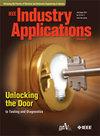Quadruped Robot Calf Joint Actuator Molding and Design Based on Dynamic Similarity Hypothesis
IF 4.2
2区 工程技术
Q2 ENGINEERING, ELECTRICAL & ELECTRONIC
引用次数: 0
Abstract
The effectiveness of a quadruped robot's speed and stability heavily relies on its calf joint actuator. Conventional approaches are no longer viable for designing calf joint actuators, given their operation in multiple modes. Crafting a suitable calf joint actuator puts forward a considerable challenge. In response to this challenge, a novel technique method is presented, drawing inspiration from the dynamic similarity hypothesis. The devised approach for designing calf joint motors provides for the accurate determination of calf joint specifications without the need for intricate analysis of kinematic motion patterns. Consequently, this methodology offers advantages such as reduced time commitment, heightened efficiency, and cost-effectiveness in crafting calf joint actuators. In this study, we investigate how variables such as leg length and body mass influence the characteristics of calf joints. The relationships, between the demands on joint speed and torque requirements in calf joints and the velocity of movement, are designed to elucidate in a model. This model incorporates a limited number of unidentified coefficients, established through the substitution of experimental data from calf joints. Moreover, this study incorporates conventional principles in the design of calf joint actuators to validate the precision of the presented methodology. Ultimately, the efficacy of the formulated procedure is affirmed through a combination of experimental testing.基于动态相似假设的四足机器人小腿关节驱动器成型与设计
四足机器人的速度和稳定性在很大程度上依赖于其小腿关节驱动器。考虑到小腿关节执行器的多种工作模式,传统的设计方法已不再可行。制作一个合适的小腿关节驱动器提出了相当大的挑战。针对这一挑战,从动态相似假设中得到启发,提出了一种新的技术方法。设计小腿关节电机的方法提供了小腿关节规格的精确确定,而无需对运动学运动模式进行复杂的分析。因此,该方法在制作小腿关节执行器时具有缩短时间、提高效率和成本效益等优点。在这项研究中,我们调查了诸如腿长和体重等变量如何影响小腿关节的特征。小腿关节对关节速度和扭矩的要求与运动速度之间的关系,被设计成一个模型来阐明。该模型包含有限数量的未确定系数,通过替换小腿关节的实验数据建立。此外,本研究还结合了传统的小腿关节执行器设计原则,以验证所提出方法的精度。最后,通过结合实验测试,肯定了所制定程序的有效性。
本文章由计算机程序翻译,如有差异,请以英文原文为准。
求助全文
约1分钟内获得全文
求助全文
来源期刊

IEEE Transactions on Industry Applications
工程技术-工程:电子与电气
CiteScore
9.90
自引率
9.10%
发文量
747
审稿时长
3.3 months
期刊介绍:
The scope of the IEEE Transactions on Industry Applications includes all scope items of the IEEE Industry Applications Society, that is, the advancement of the theory and practice of electrical and electronic engineering in the development, design, manufacture, and application of electrical systems, apparatus, devices, and controls to the processes and equipment of industry and commerce; the promotion of safe, reliable, and economic installations; industry leadership in energy conservation and environmental, health, and safety issues; the creation of voluntary engineering standards and recommended practices; and the professional development of its membership.
 求助内容:
求助内容: 应助结果提醒方式:
应助结果提醒方式:


